The bonds between Greece, Southern Italy and Apulia are particularly
owed to the proximity of the two countries which, even if they do not
have land borders, they are separated by a sea of barely 50 nautical
miles (from the coasts of Albania) and 100 miles from Corfu. The West
and the East were linked through the marine passage of the Adriatic
Sea. Through this marine channel the Greeks, in the pre-Christian era,
had colonised Italy, the Romans controlled the East, Byzantines, in
the Christian era, controlled the West, while the Francs using the
same route conquered the East; today by this same route pass the undersea
electricity lines and the pipelines that link the two countries.
The myth of the river Alpheios and the nymph Arethousa
The ancient Greeks, after their settlement in Southern Italy
and Sicily, were in need of an umbilical cord and thus invented
the myth of the river Alpheios and the nymph Arethousa (or Arethusa).
Nymph Arethousa, returning from a hunting
spree in the forests of Arkadia, entered the waters of the Alpheios
naked to get refreshed. The Alpheios was dazzled by her beauty
and revealed his love to her. Arethousa was frightened, and in
order to escape his amorous pursuit, she asked for the Artemis’
help, who wrapped her in a dense cloud and transported her above
the Adriatic Sea, leaving her on the islet of Ortygia2 and transforming
her simultaneously into a cool, fresh spring. The Alpheios, however,
did not cease the efforts and followed her wake; he crossed the
sea without being diffused with the seawater, he reached Ortygia
and was thus united with his beloved Arethousa.
2 Ortygia, meaning in Greek the island of quails.
It was the first place of settlement of the colonists who later
on founded the city of Syracuse. The fountain of Arethousa springs
to this day.
To prove this myth right, it has been said that during a hecatomb,
the waters of the river Alpheios turned red from the blood of
the sacrificed oxen and a little later on, the waters of the
Arethousa that sprung in Syracuse, also turned red.
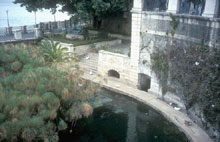 |
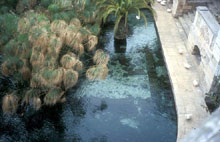 |
| The fountain of Arethousa on
the islet of Ortygia in Syracuse. The umbilical cord which
connected Corinth with its colony according to myth was founded
in 733 B.C. |
| |
|
Almost 800 years later, a new umbilical cord was created, the Egnatia
Road, which was the eastern continuation of the Appian Road (Via Appia),
and its Trajan Road (Via Traiana) detour, which started from Rome and
crossed all the way to Brindisi. Their imaginary continuation was at
the opposite land, in Dyrrachion (ancient Epidamnos), from where Egnatia
Road continued, and, horizontally, crossed the whole of the Balkan
Peninsula and ended at the straits of Hellespont and Bosphorus.
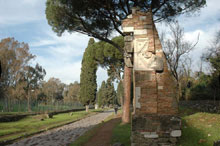 |
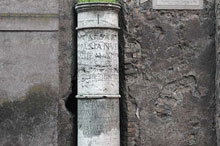 |
| Section of the Appian Road outside Rome. Funerary monuments at each side of the road are visible. |
The first migliario was outside the walls of Rome,
at the gate of St Sebastian. |
| |
The Appian Road (‘the queen of roads’ – regina viarum) was a magnificent
work for the era. In the first stage of its construction that began in
312 B.C., it reached the city of Capye (Capua). In 268 B.C., it extended
to reach Beneventum, crossed the Apennina Mountains and went on to Tarentum
(Taranto). During the 2nd century, it was extended to the ancient Brindesium,
modern Brindisi. Four hundred years later, at the beginning of the 2nd
century A.D., the Trajan Road (Via Traiana) was constructed by the Emperor
Traianus (98-117 A.D.) to the north and parallel to the Appian Road, that
followed the eastern coasts of Italy cutting the way short, which had a
final length of 650km. The route could be completed in 13 to 14 days (if
one covered about 50 km on a daily basis). The width of the street was
4,1 meters, allowing two traversing carriages to pass. At every15 km, there
were resting stations for the travellers.
The historian Diodorus Siculus (1st century B.C.) describes the construction
of the Appian Road.
[..] That year3 in Rome, censors were elected, and one of them, Appius
Claudius, having Leucius Plautius as a co-ruler and obedient collaborator,
altered many of the ancestral laws; these were changes that pleased the
people, and he paid no attention to the senate, which he thought was
of minor importance. Then, he first brought to Rome the so-called Appian
water from a distance of 80 stadia and spent much of the public money
for this construction, having no resolution of protest from the senate.
Following that, he paved the best part of the road with sturdy stones;
the road was named after him, Appian Road and leads from Rome to Capye,
covering a distance of more than 1000 stadia. In order to complete the
works, has dug the higher ground, uniting the gorges into flat roads,
and built strong, elevated walls. With this construction, he spent all
of the public income, but has left behind an immortal monument of himself,
since his ambition was all about public benefit.
3 In 312 B.C. under the consulship of M. Valerius
êáé P. Deccius.
 |
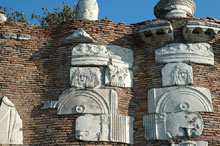 |
| Section of the original paving of the Appian
Road outside Rome, which is preserved intact today, after 2.300
years |
Funerary monument on the side of the road,
where fractions of older, funerary monuments were incorporated.
Two theatrical masks are visible. |
| |
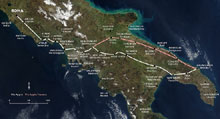 |
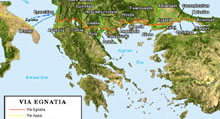 |
| The two main Roan roads crossing Southern Italy.
The Appian Road (white line) started from Rome and ended in Brindisi
(Brundisium) and its detour, the Trajan Road (pink line) which
run through an important city, Egnatia (Egnazia). |
The route of Via Egnatia in the Balkaln peninsula.
From contemporary Dyrrachion (ancient Epidamnos) through Edessa,
Thessaloniki, Philippi, ends in Istanbul (Constantinople in the
Byzantine era). |
| |
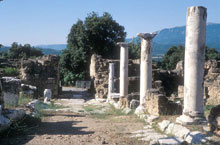 |
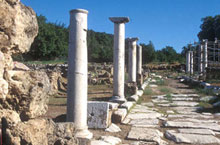 |
| Section of Via Egnatia in Edessa |
| |
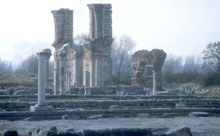 |
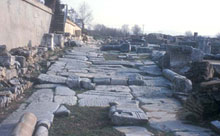 |
| Section of Via Egnatia in ancient
Philippi. |
| |
The
detour of the Appian Road, the Trajan Road, passed from the city of
Egnatia (Egnazia) - ancient Gnathia – after which Egnatia Road was
named, while, according to other sources (and rather most likely) the
name of the road came from the Roman Gnaius Egnatius who was the governor
(proconsul) of Macedonia and decided its construction. The length of
Egnatia Road was roughly 850-900 km and was constructed between the
years 146-120 B.C. On the same axis inside Greek territory, the modern-day
Egnatia Road, a high-quality motorway, has been constructed.
Contemporary Egnatia Road
In modern era, the umbilical cord of the two countries is the undersea
electricity lines and telecommunication cables as well as the gas
pipeline which will function in the decade 2010-2020.